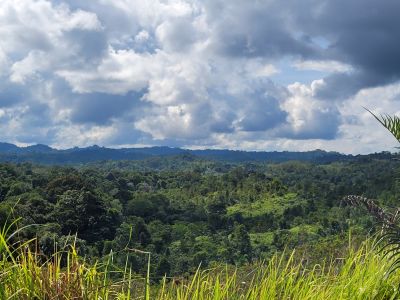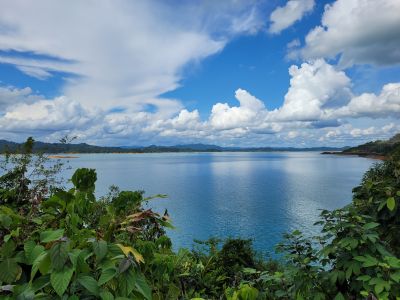Batang Ai National Park
Asia > Malaysia > Batang Ai National Park
Français | Português | Español | Bahasa Indonesia | Melayu
Summary









- Northwest Bornean orangutans (Pongo pygmaeus pygmaeus) are present in Batang Ai National Park.
- It has been estimated that 119-580 individuals occur in the site.
- The orangutan population trend is decreasing according to statistical model estimates.
- The site has a total size of 24 km².
- Key threats to orangutans are hunting and habitat loss.
- Conservation activities have focused on awareness raising and biomonitoring.
Site characteristics
Batang Ai National Park is located in Sarawak, Malaysia, bordering Indonesia to the south. The park was gazetted in 1991, after the construction of the Batang Ai dam (Horowitz 1998). Sarawak's largest ethnic group, the Iban, live in traditional longhouses around Batang Ai (Pandong 2019). Thousands of Ibans were displaced as a result of the construction of the dam and the establishment of the park. Batang Ai National Park is contiguous with the Lanjak-Entimau Wildlife Sanctuary, which also adjoins Bentuang-Karimun National Park in Indonesia; together, these three areas cover almost 10,000 sq. km and form a transboundary conservation area (WCS).
Table 1. Basic site information for Batang Ai National Park
| Species | 'Pongo pygmaeus pygmaeus |
| Area | 24 km² |
| Coordinates | Lat: 1.220503 , Lon: 111.947544 |
| Type of site | Protected area (National Park) |
| Habitat types | Subtropical/tropical moist lowland forest |
| Type of governance |
IUCN habitat categories Site designations
Ape status
Between 1999 and 2015 it is estimated that the orangutan population in the region of Sarawak, where the park is located, decreased by 900 individuals (Voigt et al. 2018).
Table 2. Ape population estimates reported for Batang Ai National Park
| Species | Year | Occurrence | Encounter or vistation rate (nests/km; ind/day) | Density estimate [ind./ km²] (95% CI) | Abundance estimate (95% CI) | Survey area | Sampling method | Analytical framework | Source | Comments | A.P.E.S. database ID |
|---|---|---|---|---|---|---|---|---|---|---|---|
| Pongo pygmaeus pygmaeus | 2004 | 119-580 | Batang Ai National Park | Line transects | Wich et al. 2008 |
Threats
Table 3. Threats to apes reported for Batang Ai National Park
| Category | Specific threats | Threat level | Description | Year of threat |
|---|---|---|---|---|
| 10 Geological events | Absent | |||
| 12 Other threat | Absent | |||
| 2 Agriculture & aquaculture | 2.1 Annual & perennial non-timber crops | Present (unknown severity) | Oil palm plantations continue to expand in the region, threatening to encroach orangutan habitat (Pandong 2019). | Ongoing (2019) |
| 2 Agriculture & aquaculture | 2.2 Wood & pulp plantations | Present (unknown severity) | Industrial forest plantations growing in the region, which threaten to encroach orangutan habitat (Pandong 2019). | Ongoing (2019) |
| 4 Transportation & service corridors | 4.1 Roads & railroads | Present (unknown severity) | High density of logging roads in the region facilitates access for hunters (Pandong 2019). | Ongoing (2019) |
| 5 Biological resource use | 5.1 Hunting & collecting terrestrial animals | Present (unknown severity) | In 2016, the carcass of a flanged male orangutan with gunshot wounds was discovered at the proposed northern extension of Batang Ai National Park (Pandong 2019). A longhouse community living near the park reported that hunters from nearby villages and towns come into the area to hunt orangutans and other wildlife (Ordaz-Nemeth pers. comm. 2023). | Ongoing (2023) |
| 1 Residential & commercial development | Unknown | |||
| 3 Energy production & mining | Unknown | |||
| 6 Human intrusions & disturbance | Unknown | |||
| 7 Natural system modifications | Unknown | |||
| 8 Invasive & other problematic species, genes & diseases | Unknown | |||
| 9 Pollution | Unknown | |||
| 11 Climate change & severe weather | Unknown |
Conservation activities
In 2003, the Sarawak Government legalized the Sarawak Forestry Corporation (SFC) to be the Forest Department’s operating arm in managing protected areas and biodiversity conservation in the state. Management changes included greater emphasis on reducing losses and numbers of park staff, as well as reduction in community conservation and communications in totally protected areas, including at Batang Ai National Park. The changes led to general unhappiness among the privileged communities and reduced commitment to protect conservation targets by park authorities, resulting in minimal control over illegal hunting and encroachment into the protected areas at the time.By the 2010s, there were multi-agency efforts to conserve orangutans, address the livelihoods of affected local communities and clarify agency roles and jurisdictions (Pandong 2019).
Table 4. Conservation activities reported for Batang Ai National Park
| Category | Specific activity | Description | Implementing organization(s) | Year of activity |
|---|---|---|---|---|
| 2 Counter-wildlife crime | 2.11 Implement monitoring surveillance strategies (e.g., SMART) or use monitoring data to improve effectiveness of patrols | SMART patrols implemented by WCS Malaysia and the Sarawak Forestry Corporation (Pandong 2019). | Ongoing (2019) | |
| 4 Education & awareness | 4.4 Regularly play TV and radio announcements to raise ape conservation awareness | The orangutan radio program entitled “Jerita Bujang Sigat” or “The Saga of Bujang Sigat” was developed and aired to disseminate information about the importance of the park and its ecosystem services as well as to engage local communities to conserve orangutans and other wildlife (WCS). | 2011-2012, 2018 | |
| 4 Education & awareness | 4.5 Implement multimedia campaigns using theatre, film, print media, discussions | An orangutan conservation education and awareness program was conducted by WCS with Sarawak Forestry Corporation (SFC) and also with the assistance of some of the local communities (WCS). | Unknown | |
| 4 Education & awareness | 4.5 Implement multimedia campaigns using theatre, film, print media, discussions | The Participatory Photography event with the theme, “Appreciating nature through pictures”, was held at SK. Nanga Delok, a primary school near Batang Ai National Park. This is a boarding school with students from different longhouse communities in the area (WCS). | Unknown | |
| 5 Protection & restoration | 5.2 Legally protect ape habitat | The site was established as a National Park in 1991. | Ongoing (2023) |
Conservation activities list (Junker et al. 2017)
Challenges
Table 5. Challenges reported for Batang Ai National Park
| Challenges | Specific challenges | Source | Year(s) |
|---|---|---|---|
| 3 Engaged community | 3.1 General lack of community engagement or support | Pandong 2019 |
Enablers
Table 6. Enablers reported for Batang Ai National Park
| Enablers | Specific enablers | Source | Year(s) |
|---|---|---|---|
| 1 Site management | |||
| 2 Resources and capacity | |||
| 3 Engaged community | |||
| 4 Institutional support | |||
| 5 Ecological context | |||
| 6 Safety and stability |
Research activities
Documented behaviours
Table 7. Behaviours documented for Batang Ai National Park
| Behavior | Source |
|---|---|
| Not reported |
Exposure to climate change impacts
External links
Relevant datasets
References
Horowitz, L. S. (1998). Integrating indigenous resource management with wildlife conservation: A case study of Batang Ai National Park, Sarawak, Malaysia. Human Ecology, 26(3), 371-403.
Pandong, J. (2019). Conservation Ecology of Bornean Orangutans in the Greater Batang AiLanjak-Entimau Landscape, Sarawak, Malaysia [Master's thesis, The University of Adelaide.
Wich, S.A., E. Meijaard, A.J. Marshall, et al. 2008. Distribution and conservation status of the orang-utan (Pongo spp.) on Borneo and Sumatra: how many remain? Oryx. 42: 329–339.
Voigt, Maria, Wich, Serge A., Ancrenaz, Marc, Meijaard, Erik, Abram, Nicola, Banes, Graham L., Campbell-Smith, Gail, d’Arcy, Laura J., Delgado, Roberto A., Erman, Andi, and others. (2018). Global Demand for Natural Resources Eliminated More Than 100,000 Bornean Orangutans. Current Biology, 28 (5). pp. 761-769. ISSN 0960-9822. (doi:10.1016/j.cub.2018.01.053) (KAR id:66068)
WCS. (n.d.).WORKING TOWARDS CONSERVING ORANG-UTANS AND THEIR HABITATS.https://malaysia.wcs.org/Wild-Places/Working-towards-conserving-orang-utans-and-their-habitats.aspx
WCS. (n.d.). Orang-utan.https://malaysia.wcs.org/Wildlife/Orang-utan-conservation-in-Sarawak.aspx
Page created by: A.P.E.S. Wiki team Date: NA

